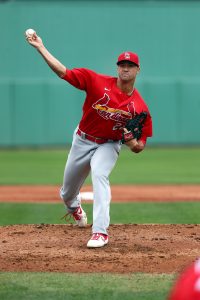Before the coronavirus pandemic struck, the Cardinals were set to begin the regular season without some notable pitchers dealing with injuries. But if a season gets underway around midsummer, the Cardinals’ pitching staff could be at or near full strength, as Derrick Goold of the St. Louis Post-Dispatch explains.
Right-hander Miles Mikolas, who underwent a platelet-rich plasma injection in his ailing forearm in February, is making progress in his recovery. The Cardinals expect him to be ready for the start of the season, according to Goold. That’s a relief for both the short and long term, as forearm issues are often a precursor to Tommy John surgery. That outcome would have been disastrous for the Cardinals, who signed Mikolas to. a four-year, $68MM extension before last season and have seen him turn in back-to-back fine campaigns after he returned to the majors following a dominant stint in Japan.
Turning to the Cardinals’ bullpen, closer Jordan Hicks and lefties Andrew Miller and Brett Cecil are also coming along. The fireballing Hicks had TJS last June, and under normal circumstances, he’d have missed a sizable chunk of this season. However, he’s now throwing at “moderate intensity,” president of baseball operations John Mozeliak told Goold, and seems to be on track for a July return. That could mean the Cardinals will get Hicks for some or all of a potential season.
Miller, who battled a mysterious arm problem before spring training stopped, now looks as if he’ll be good to go from the outset. Cecil’s status isn’t as clear. He suffered a major hamstring injury in mid-March, and while he should resume throwing within the next two weeks, it’s unknown if he’ll be shelved at the beginning of a possible season.
If they’re healthy, the Cardinals will need more from Miller and Cecil, recent free-agent signings who haven’t panned out to this point. The formerly dominant Miller struggled to a 4.45 ERA/5.19 FIP over 54 2/3 innings last season – the first of a two-year, $25MM contract. And Cecil, the recipient of a four-year, $30.5MM pact prior to the 2017 campaign, endured an abysmal 2018 and then didn’t pitch at all last season after he had surgery on carpal tunnel syndrome in his left hand. Of course, with Miller and Cecil eligible to return to free agency next winter, it’s possible neither will pitch for the Cardinals again if a season doesn’t take place.

